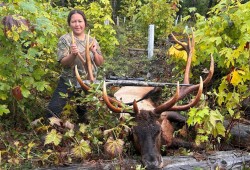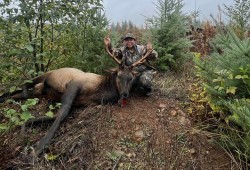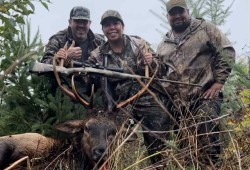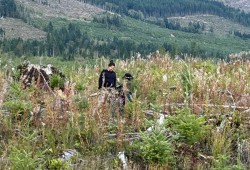Tseshaht First Nation members Leisa Hassall, 36, and Sylvia Dick, 38, shot their first Roosevelt elk this fall.
Hassall dropped a four-by-four bull in the Comox Main area on Sept. 27 and Dick took down a massive seven-by-seven Imperial in the Taylor Arm area on Sept. 29.
“When I harvest animals, I am always thanking the Creator. Being connected to our culture and our traditional prayer is always a meaningful way of grounding ourselves,” said Hassall, who was hunting with her husband John Morgan Hassall and brother Jordan Dick when she shot her first-ever elk.
“As soon as he dropped, I said thank you, klecko klecko Naas. You just call on the Creator to always watch over you during the hunt,” she said, adding that she placed her hands on the animal and gave thanks for her family and the community as well.
Hassall said she made the mistake of approaching the animal too soon after it dropped.
“I should have been more careful,” she said. “My brother said, ‘Just let him sit’, but I was too excited. I started walking down, it was a 300-yard shot, I didn’t listen to my brother, and as I got closer, the elk got up and tried to run away.”
“He could have charged at us. That was a big lesson I learned. When you shoot a big animal, it takes longer to die,” she continued.
Tseshaht draws four elk tags each year with about 30 to 40 members throwing their names in the hat. The lucky elk tag winners keeps half of the meat and the other half the elk is distributed to the community of about 1,267 members.
Every year, for the past 10 years or so, Dick enters Tseshaht’s elk draw but has never been selected.
“I had a feeling this year I was going to get picked and sure enough, I got picked,” said Dick.
She says the Imperial bull elk she shot with her spouse, Rick Mack, was one of the biggest she’s ever seen.
“I was so shaky loading the gun, but I shot it. I knew I shot it because it didn’t run. I had to wait 40 minutes until it died. I sat with it until it’s last breath,” she said.
Hassall says she usually puts her name in the elk draw, but thinks that if she had won it earlier, she wouldn’t have been ready.
“My kids were so much younger and I didn’t have the time to prepare myself, but this year I was prepared. I’ve been so busy my entire life working, being a mom, usually taking some sort of training or being in full-time school, but this year I’m only working and being a mom, so I was really able to engage in the hunt and take in every moment of the experience,” she shared.
“It was such an empowering feeling as a Tseshaht woman. Not a lot of us hunt, but we respect each other,” said Hassall.
Dick echoes the feeling.
“I can’t explain it. It’s very overwhelming. As soon as I saw (the band) post that they were handing (the meat out) to the community it made me really happy that I could do that for my community,” said Dick.
“There aren’t a lot of Nuu-chah-nulth women who hunt and I hope our stories inspire them to try,” Dick continued.
‘He would always have a story when he was eating his meal’
Hassall and Dick both come from hunting and fishing families. As young girls, they used load up on čamas (delicious treats) and sit together on the logging roads while their grandpas, dads and uncles were on hunts, Hassall shared.
Weeks before Hassall got her elk, she was out on the land scouting locations with her 11-year-old son Riley. She says a lot of the love she has for hunting stems from teaching her children all the things her brother, uncles and grandpa taught her, from gun safety to culture.
“When the fishing season or hunting come, we’re already preparing ourselves. We’re going for dips, we’re washing away the negative energy. We’re not bringing any bad energy into our hunt,” she said.
“We respect the land,” Hassall went on to say. “I come from Tseshaht First Nation, and we respect the territories and remind people to respect the land and be cautious of the area you’re in; be respectful to other hunters and land users.”
The elk Hassall has in her freezer will last her family up to three years, she says, and includes steaks, roasts, elkburger and stew meat.
“It’s so lean. It’s so tender. When it’s ground up and you’re making spaghetti or chili I don’t think people notice the difference and if they do it’s that the meat tastes cleaner, less fatty,” she described. “The roasts are just so tender. They have such a beautiful taste to it.”
Her kids, Riley and Lanaley, appreciate eating traditional food too.
“Ever since (Riley) was young he had to know where his food is coming from. He had challenges eating hamburger and chicken,” said Hassall.
“He loved catching fish and eating it himself. He loved going on hunts and processing the deer. He would always have a story when he was eating his meal,” she continued.
Dick gave most of her portion of the elk away, feeding about 10 other families.
“I shared it with everybody. I shared my half with people that were close to me. I even gave more than half to the band,” said Dick.
Hassall saved the stomach lining of the elk to make traditional skincare and gifted the heart of the majestic forest animal to an elder.
B.C.’s Roosevelt elk population is stable to increasing
Named for Theodore Roosevelt, the 26th president of the United States (1901-1909), the Roosevelt elk, or ƛ̓uunim in Tseshaht language, is Vancouver Island’s largest land animal, weighing over 1,000 pounds.
Roosevelt elk herds are restricted in B.C. to Vancouver Island and portions of the southwestern mainland. According to the B.C. Ministry of Forests, Lands and Natural Resource Operations, successful transplants of 24 animals from Vancouver Island to the Sechelt Peninsula between 1987 and 1989 helped off-set local declines. There was also one transplant of five animals to Powell River in 1994, according to the ministry.
“The present mainland populations are almost all descendants of 29 elk transplanted from Vancouver Island,” said the BC Conservation Data Centre.
The animal is currently considered to have a “stable to increasing” population with aerial surveys from 2022 estimating the number of Vancouver Island Roosevelt elk at 5,600 to 6,300, according to provincial data.
While the population is stable, Roosevelt elk in coastal forests still remain vulnerable to unregulated hunting, predation and habitat degradation, according to the ministry.
“Over-winter mortality during periodic severe winters, which may become more frequent as a result of climate change, can also significantly reduce elk populations,” said the ministry.
The ministry went on to say that elk populations within the traditional territories of most Nuu-chah-nulth First Nations are estimated to be small.
“There are limited sustainable hunting opportunities in these areas as hunting could jeopardize elk conservation,” said the ministry in an email.
For 2025, 16,347 hunters applied for a Roosevelt elk Limited Entry Hunting (LEH) authorization in region 1 (Vancouver Island) and 7,072 applied in region 2 (Lower Mainland), for a total of 23,419, according to the Ministry of Water, Land and Resource Stewardship.
In 2025, there were 187 authorizations issued for Roosevelt elk in Region 1 and 487 in region 2, for a total of 674 or about one for every 35 licensed B.C. resident hunters that applied for a Roosevelt elk LEH received one.
On average, there are about 115 Roosevelt elk harvested in region 1 and region 2, according to the ministry. They say wildlife managers anticipate a similar harvest for 2025.
The ministry said the LEH information provided is specific to licensed B.C. resident hunters and does not consider First Nation harvest intentions that are discussed at government-to-government meetings, and does not consider guided hunters who access quotas issued to guide outfitters.
Roosevelt elk hunting opportunities that are available to licensed hunters are allocated between resident and guided hunters following the Harvest Allocation Policy, said the ministry, and on Vancouver Island, roughly 85 per cent of the harvest is though the LEH process and 15 per cent of the harvest is available to guided hunters through the guide quota system.
Both Hassall and Dick are looking forward to their next Roosevelt elk hunt, but they’ll have to skip next years’ draw – in accordance with Tseshaht’s hunting regulations, members can’t win a Roosevelt elk tag two years in a row.





